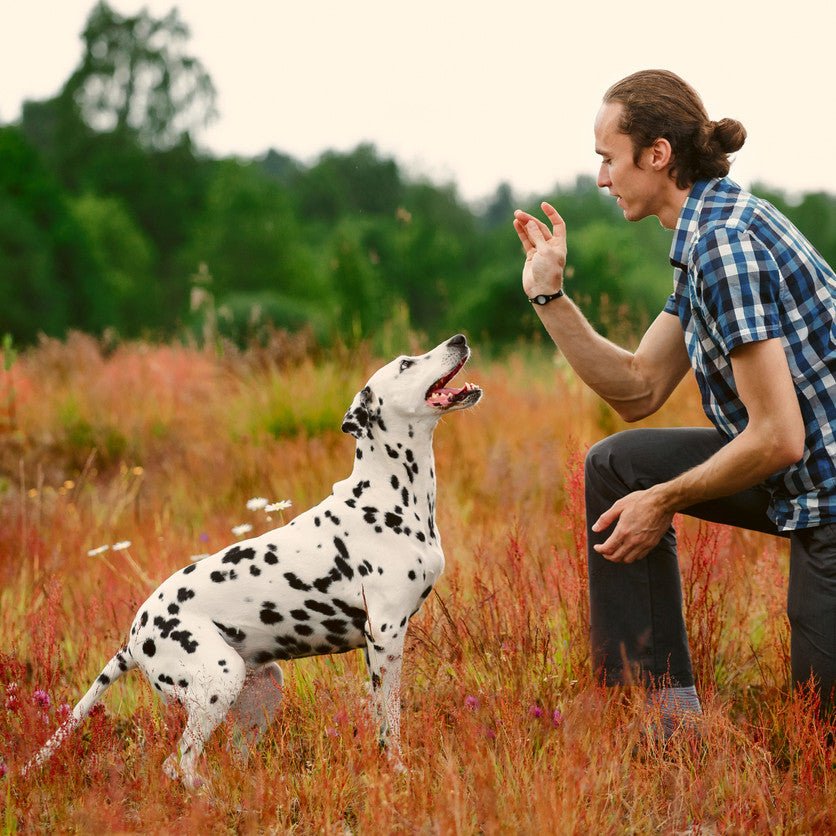Learn to Build Trust With a Dog Who Is Shy or Aggressive

Whether you encounter a menacing German shepherd or a shaking, scared-looking small dog, your behavior toward that animal usually dictates how they'll respond. So if you want to build trust with a dog, you need to know what to do. Here's valuable insight to help you better understand dogs that act aggressively or scared, along with some tips for building mutual trust with your best friend.
Interacting With a Shy Dog Is Almost the Same as With an Aggressive Dog
In both cases, you're dealing with a dog that is uncomfortable with a situation and is likely protective of its personal space. That's why it's best not to try and act dominant over a dog that's acting aggressively. Also, avoid approaching a shy dog until you've earned its trust.
Here are some tips for putting dogs at ease:
- Avoid direct eye contact.
- Regard the dog's kennel or bed as its safe space.
- Don't crowd agitated or nervous dogs.
- Dog owners should praise and treat their dogs when they act positively or neutrally to new people or situations.
- Don't shove your hand in a scared dog's face for them to sniff.
- Speak to aggressive or scared dogs in a soft, friendly voice.
- Let a shy dog approach you first.
- Do not play "alpha dog" with a dog that acts aggressively toward you.
Aggressive Behavior Is a Dog Warning You That They’re Uncomfortable
If an aggressive dog lunges at you, your priority is protecting yourself. Put an object between you and the dog (such as a purse or backpack) and leave the area immediately. Do not punish a pet that's acting aggressively; they're telling you in their own language that the dog needs their space or feels threatened. Usually, a dog slowly escalates aggressive behavior when previous attempts to "ask" for space (posturing, growling, nips, or lunges) are ignored or punished.
Any dog can be aggressive, whether it's a burly pit bull or a shaggy, friendly-looking border collie. So never assume a dog is okay with being touched.
If the dog acting aggressively is yours, it's essential to start training sessions with a skilled behaviorist right away to identify the stressors. Dogs that feel "forced" to escalate aggressive behavior are all too often—and avoidably—euthanized.
How to Work With a Dog That Is Possessive Over Its Toys, Food, and Safe Space
"Resource guarding," also known as "possessive aggression," is the label for a dog's hostile behavior when the caregiver tries to take away food, toys, or bedding. How would you behave if someone kept trying to "steal" from you?
You can build trust with a possessive dog by offering to "trade" a more valuable item, like a special, extra-tasty treat when you have to move or clean their kennel or bedding, take their food or empty dish away from them, or take away a favorite toy.
If a dog already shows severe aggression under these circumstances, you can have a helper restrain them on a leash well out of reach (but within sight) of the item. Then treat the dog when it shows neutral or positive behavior when you approach the item.
This is a slow, gradual process in which you inch closer while paying attention to the dog's body language. You can read more about this training technique in this American Kennel Club article.
Also, it's advised to seek help from a skilled trainer if your dog doesn't respond to positive reinforcement techniques and you need more advanced help to build trust with a dog.
Does Neutering Reduce Dog Aggression?
Studies performed on both neutered and intact dogs show mixed results. But many veterinarians and trainers in the U.S. recommend spaying and neutering dogs not intended for breeding. Since spaying and neutering dogs have never been shown to cause aggression, dog owners should seriously consider the procedure for their pets.
How a Pet Behaviorist Can Help You Build Trust With a Dog
You can quickly learn dog training techniques used to help shy, fearful, and aggressive dogs. There are excellent books on Amazon to help you along the path to build trust with a dog. Still, the best way to get started is to have a certified pet behaviorist evaluate your dog. They can then show you and your family members how to apply dog behavior training fundamentals to your specific pet.
These techniques include:
- Desensitization: Gradually expose your dog to a triggering situation.
- Counter conditioning: Build positive associations with a trigger.
- Positive reinforcement: Treat or praise a dog that acts positively (or neutrally) to a trigger.
- Socialization tips: Your dog trainer will help you set the pace for socializing your dog. They'll also give you advice on introducing your furry best friend to new dogs and people.
The behaviorist dog trainer can also help you learn to read your dog's body language and teach you the subtle warning signs and triggers for a potential attack. This gives you the tools you need to remain safe, confident, and positive while working with your dog.
Don’t Have a Fearful Dog? Are You a New Dog Owner?
Behaviorists are helpful to all first-time dog owners and even for experienced pet parents bringing home a new dog, especially if it's a rescue dog that's been through a lot of emotional—or possibly physical—trauma. You can build trust from day one and reduce the chances that you'll have a nervous dog down the line. It's better to be proactive than reactive if you want a well-adjusted pooch!
Give Your Dog a Safe Space With Animals Matter Luxury Dog Beds
Our orthopedic dog beds and rugs are designed for style and comfort so that your dog feels they have a safe retreat to spend time on their own. Be sure to contact us if you want to know more about our organic, eco-friendly products. Also, check out our blog, where you can learn more about dog behavior, training, health, and nutrition!
Quick FAQs
How do you build trust with a shy dog?
Let a shy dog approach you first, and speak to it in a calm, friendly, soft voice. Never try and cuddle a dog that is retreating from you.
How does a dog know when you can be trusted?
Consistent, non-aggressive behavior on your part can help you build trust with a dog. When you respect its personal space, a dog will feel like it can trust you and will likely feel more comfortable approaching you.
What is the first step if you want to build trust with a dog?
If you've brought home a new dog, either a shelter dog or one you've purchased from a breeder, you should enlist the help of a professional dog trainer. They will work with you, your dog, and your family members to build a good foundation for trust and help avoid future problems with dog aggression.
Subscribe
Sign up to get the latest on sales, new releases and more…
Categories
- Tails of Celebration: Working Dogs of the Lares Trek, A Silent Partnership In Peru
- 5 Easy Organic Christmas Recipes for Dogs: Simple Holiday Treats Your Companion Will Love
- The 6 Best Luxury Gifts for Your Dog This Christmas: Thoughtful Holiday Comfort That Truly Lasts
- Why Playtime Matters: The Benefits of Mental Stimulation and Playtime with Your Companion
- Tails of Celebration: The Miao Dog-Carrying Festival - A Hero's Honor in China
- A Dog-Friendly Thanksgiving 2025: Comfort, Calm, and Easy Treat Recipes
- The Best Dog Beds for Winter 2025: 5 Luxury Styles for Warmth, Comfort & Orthopedic Support
- Tails of Celebration: The Feast of Saint Hubert — Belgium's Timeless Blessing
- Halloween Safety Tips for Dogs: How to Keep Your Companion Safe This Spooky season
- Tails of Celebration: Día de los Muertos / Day of the Dead for Pets, A Festival of Memory in Mexico
- How to Care for Senior Dogs in Fall: Mobility Tips & Joint Support
- Tails of Celebration: Kukur Tihar & The Tihar Festival of Nepal
- What is a VDI Testing for dogs ? : Insights, Procedures and Preventive Measures
- Cheap Dog Beds vs. Luxury Dog Beds: The Real Cost of a $50 "Disposable" Dog Bed
- Can Dogs Have OCD? Understanding Canine Compulsive Behaviors (CCD)
- Does My Dog Like Music? Find Out What Tunes Make Your Pup Wag!
- Effective Solutions for Food Aggression in Dogs
- 7 Frozen Treats Your Dog Will Love This Summer☀️🧊🍉
- The Best Waterproof Liners for Dog Beds: Protect Against Spills, Drool, and Accidents
- How to Cope with the Loss of a Dog: A Tribute to Every Companion We Carry in Our Hearts
- Top Tips on How to Prevent Matting in Dogs
- Understanding and Managing Dogs with Hip Dysplasia
- The Ultimate Guide to Dog Gut Health: Natural Remedies, Probiotic Insights and Signs of Poor Gut Health
- The Best Supplements for Dogs: Explore Top Picks for Canine Health and Wellness
- How Often Should I Brush My Dog's Teeth? Tips for Optimal Canine Dental Health
- Ultimate Guide on How to Comfort Your Dog During Fireworks this 4th of July
- Managing a Blowing Coat: Essential Grooming Tips for Double-Coated Dogs.
- 5 Daily Habits That Boost Your Dog’s Long-Term Wellness
- Mastering Crate Training a Dog: Tips and Benefits
- Dog Car Seats vs. Seat Covers: What’s The Best Option For Your Companion?
- Best Outdoor Dog Beds: Luxury, Durability, and Unmatched Comfort
- Is My Dog Overweight? Tips to Assess and Help Your Companion
- The Best Faux Fur Dog Beds for Ultimate Pet Comfort of 2025
- Dog Running Guide: How to Start, Train & Stay Safe when running with your Dog
- Indestructible Dog Beds? The Truth Behind the Term
- Top Tips for Effective Exercise for Dogs
- Effective Dog Ear Cleaning: A Step-by-Step Guide for Maintaining Healthy Ears
- How to Manage Dog Aggressive Behaviors: Expert Tips and Advice
- Effective Canine Ear Infection Remedies: Symptoms, Causes & Treatments
- How to Make a New Dog Comfortable in Their New Home - 2025 Guide
- Signs of Dog Allergy Symptoms and How to Help and Prevent Them
- Why Does My Dog Lick Their Paws? Causes and Solutions Explained
- Dog Alzheimer's: Symptoms, Causes, and Treatment Options
- The Legacy of Comfort with the Iconic Animals Matter® Ortho Companion-Pedic® Puff Luxury Dog Bed
- Orthopedic Square Dog Beds: The Ultimate Blend of Luxury, Comfort, and Support
- Loungers: The Ultimate Beds for Luxury, Comfort, and Orthopedic Support
- Square Dog Beds: Orthopedic Comfort and Stylish Designs for Your Companion
- Effective Solutions for Canine Incontinence: Identifying Causes and Best Treatments
- Ethical, Sustainable, and Certified: Why Certified Products Matter, Exploring CA Prop 65 and CertiPUR-US® Standards
- Dog Seizures: Signs, Causes, and How to Help Dogs with Seizures


Leave a comment
Please note, comments must be approved before they are published